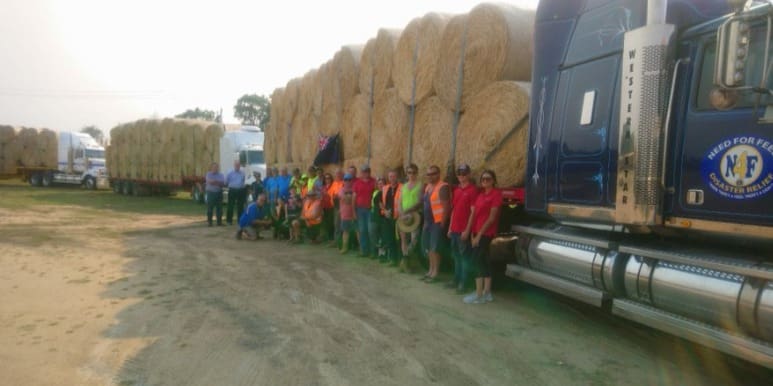
Knowing how much hay and grain is available will help with farmers’ bushfire and drought recovery decisions. Source – NSW Farmers Twitter.
GREATER transparency in grain and hay stocks information would assist bushfire and drought recovery as well as supply chain sustainability and livestock market volatility, according to supporters of a national database concept proposed by the grains and fodder sectors.
At the recent Bushfire Roundtable meeting in Canberra, national grain farmer body GrainGrowers and the Australian Fodder Industry Association highlighted the need for national databases for better insight into livestock feed stocks and demand.
And with drought and now bushfire exacerbating declining fodder supplies and feed grain availability, the national grain and fodder supply database concept is also supported by livestock agency and lot-feeding interests.
Many large beef and lamb feedlots forward contract their seasonal feed needs, but small farm-based lamb lotfeeders are already experiencing difficulty sourcing preferred protein sources such as lupins due to drought and now bushfire-affected livestock demands.
Nutrien Ag national commercial livestock manager Mark Barton supported the fodder and grain database concept to give greater transparency, which would potentially removing some volatility from the animal production supply chain.
“While there is a competitive advantage to having information to yourself, I think the more transparent the market is, the better long-term the whole supply chain will be.
“Information is power, but the more transparent the supply chain is, long-term that has got to be to our advantage,” he said.
“The frustration is that value keeps shifting up and down the supply chain; one year the processor kicks a goal and the next year he gives it back, the cocky gets a quid then the grain grower gets a quid – we just want to try to even out those bumps.
“I think more transparency helps give us a more stable market after we get past this terrible season.”
Mr Barton said knowing what fodder and grain supplies are available would drive a more stable market and supply chain.
He said since the bushfires across New South Wales, Victoria and South Australia, his lot-feeding clients in NSW are dealing with hay price rises of around $100 a tonne, and generally for cereal and vetch hay.
“Prices for high protein grains going into an intensive system continue to increase and availability is a real issue.”
The availability of fodder and grain supplies has also kept restockers conservative in their buying decisions, he said.
With the drought and now bushfires limiting backgrounding options, the fodder and grain prices and availability was “keeping a lid on” restocker activity and the numbers being bought, he said.
“The reality is you’ve got to have a ration to keep them going.”
It would also be valuable if the proposed databases enabled potential buyers to find fodder and grain supplies, he said.
“There are platforms there that would pretty quickly lend themselves to that sort of process.
“It would almost be an ebay for agricultural commodities.”
We don’t know if there is enough grain available — GrainGrowers
GrainGrowers chairman and Quambatook farmer Brett Hosking said the body had been asking for development of a regulated grain stocks database for a number of years. He said the deregulation of the industry had shifted a lot of the market intelligence and power from the bulk handlers to private entities.

Brett Hosking
“We have called for transparency of information so anybody could access the information about stocks were in what part of the country.”
This would give livestock producers and others a clear picture of what grain was available, he said.
“We felt that market intelligence was important for a truly competitive marketplace.”
The impact of that lack of market intelligence was being played out now in the challenges around fodder and feed grain demand, he said.
Mr Hosking said a livestock producer trying to retain animals during a drought or after a bushfire needed to know the fodder and grain needed is available.
In the current climate, transparency around fodder and grain supplies could potentially be an animal welfare issue, he said.
Fodder and grain supply transparency was a necessity for industry sustainability as more extremes in climate are being experienced, Mr Hosking.
“I think we are seeing these extremes in the climate and I think we need to makes sure we have a marketplace that allows for that.”
Mr Hosking said grain prices have increased post-harvest and the 2020 season had not yet “shown it’s hand”, he advised lot-feeders and others needed future supplies to start looking now.
“We actually don’t know whether there is enough grain and hay in the country to meet domestic requirements.”
Livestock producers still in or coming out of drought, and those feeding surviving sheep and cattle after a bushfire need transparency in fodder and grain supplies to made decisions on whether to sell or retain stock in containment areas, he said.
Mr Hosking said there needs to be a level of independence in the management of the information generated for a supply database, to ensure trust and a level of privacy.
“But as an industry, we need to all agree on the level of reporting that is required and if we all agree on that then we will get a better outcome because people will be more honest and transparent – the success of it will be in the transparency.”
Domestic fodder production and sales data is not recorded
Australian Fodder Industry Association chief executive John McKew last week ramped-up calls for a market database. He said the recent bushfire crisis, coupled with on-going drought, was depleting the low national fodder stocks.
“Industry representatives continually ask ‘how much fodder is in the system? Where is it going? How much is there in reserves?” he said.
“Quantitatively – I don’t know.
“The industry doesn’t know,” he said.
“That information is not recorded for domestic fodder production and sales.
“What we know is qualitative information.”
Mr McKew said in times of drought and bushfire recovery, there needed to be more transparency in the market so Australian agriculture has the capacity to forecast feed requirements and plan.
“It is something everyone wants, it was mentioned by the grains industry, and there’s value across a lot of industries, but it is a hard nut to crack.”
Mr McKew said the need for better data was a theme of the discussions at the Canberra meeting.
While the roundtable was a first step in a long process, Mr McKew was buoyed by the Agriculture Department’s “sympathetic ear” regarding the database.
He hoped government involvement would provide the much-needed assistance and funding, which had previously been lacking, to develop a model to allow Australia’s agricultural industry to better manage seasonal risk.
During his address to the roundtable, Mr McKew praised the agricultural industry for banding together to donate fodder, and the subsequent transport, to fire-affected farmers.
But he stressed the urgent need for fodder in bushfire regions would further drain the nation’s low stocks.
“Australia will not necessarily run out of fodder, but the quantities available for trading – available for those who need to buy it in quantity – could run out,” he said.
“AFIA has been told that some farmers with stocks of hay have held-off putting it into the marketplace due to the uncertainty clouding the season and a need to sustain their own livestock enterprise.”
Importing fodder won’t be an option either, according to Mr McKew.
“The biosecurity risk is too high, and the Agriculture Department has said that in the past too,” he said.
“We could potentially end up with a lot of worse problems linked to imported weeds and diseases.”

So are the eastern Australian agro political wanabees stating market failure ? If so then they will also need to regulate the end users to state their needs and how much they have already purchased and at what price so the suppliers know what to produce. My view is that if buyers think the commercially available information platforms aren’t enough then they can build storage and buy when it is cheap and get away from this “just in time” ideal. The greatest majority of the storage infrastructure spend has been done by suppliers. 3 years ago I had hay in sheds that no-one wanted. All the information flows in the world couldn’t help me sell it. I could have cried market failure. When I sold it I gave as much info as I chose as I considered it my prerogative as I had the product AND THE SHED. There is no market failure. Simply an imbalance in expectations and capacities.